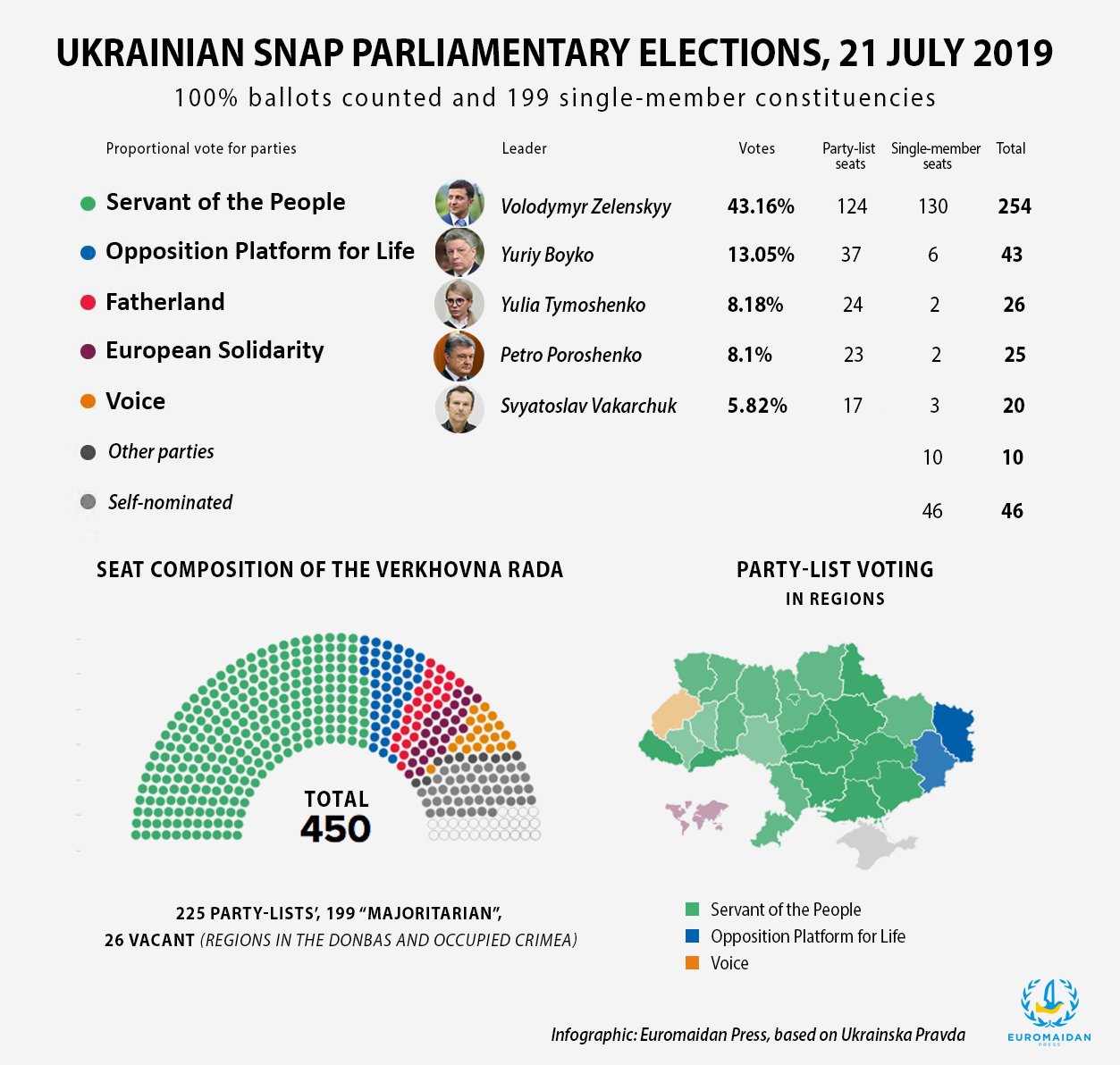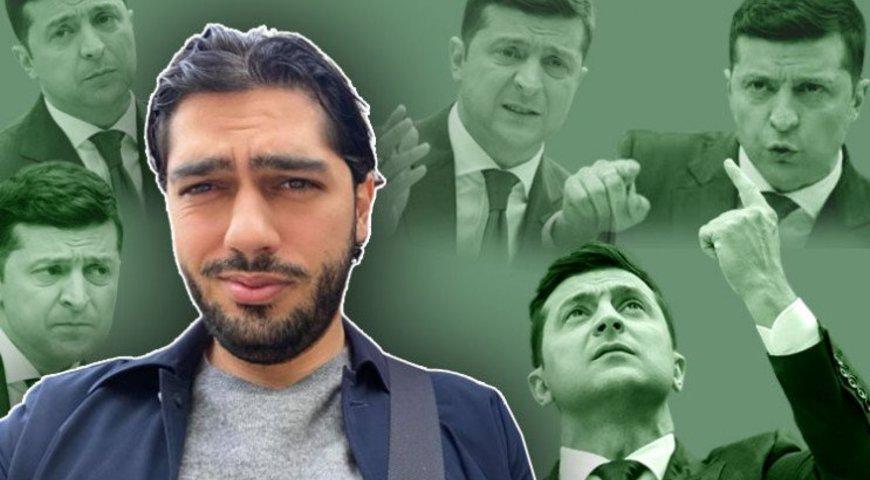Other things to note:
- The lowest turnout in Ukrainian history.
- The party of Volodymyr Boiko and Putin's crony Viktor Medvedchuk, Opposition Platform For Life, the largest shard of fugitive president Viktor Yanukovych's defunct Party of Regions, comes second in the race, while oligarch Akhmetov's shard loses;
- parties by former president Poroshenko and ex-PM Yulia Tymoshenko's will have 24 MPs each;
- another showman with a newly-created party gets into the Rada;
- the far-right fall far below the electoral threshold once again.
(This article was updated as the vote counting progressed).

Lowest turnout in historyy
The 2019 snap parliamentary elections gathered the lowes turnout in Ukrainian history - only 49.8%. The timing of the elections during vacation time may be one explanation for this. The 2019 presidential elections had a significantly higher turnout: 62.9% in the first round on 31 March and 61.4% in the second round on 21 April.

Image: Ukraine World
For the first time in Ukraine, a mono coalition
According to the Ukrainian Constitution, a newly elected parliament has a month to form a coalition from the deputy factions comprising "a majority of people’s deputies of Ukraine in the constitutional membership of the Verkhovna Rada."
The Central Electoral Commission continues updating the results of the vote count, but it is already clear that comedian-turned-president Zelenskyy's party "Servant of the People" will have the parliamentarian majority of 254 MPs on its own even without a need to form an inter-faction coalition. It won 43.16% of the proportional vote, which translates to 124 seats, and received 130 more majoritarian seats.
"Our goal is a mono coalition," claimed
Zelenskyy's team chief ideologist, lawyer Ruslan Stefanchuk. And the goal seems to be achieved. The single party would now be able to pass any bills and resolutions in the Verkhovna Rada.
"Servant of the People" will now be able to form the entire government and approve any presidential nominations for the posts of the prosecutor general, the head of the Security Service, the foreign minister and several more.
Zelenskyy now effectively consolidates nearly absolute executive and legislative power in Ukraine, getting full control of not only the country's foreign policy and the army but also of the domestic policy. A majority in the Rada will allow passing any laws he wants.
The only obstacle on Zelenskyy's way to absolute legislative power is that his majority in the parliament won't be able to amend the Consitution, which requires the so-called "constitutional majority" of 300 or more legislators. However, this obstacle can be removed by blocking with other parties such as the Opposition Platform For Life, Fatherland, Voice, and with independent self-nominated "majoritarian" deputies.

Overtly pro-Russian party gets more seats than in 2014
As president Viktor Yanukovych fled to Russia in 2014, his "Party of Regions" collapsed and split into several pieces. The biggest shard, the political party Opposition Bloc, entered the parliament that fall with 9.4%, receiving 27 proportional seats and scoring two more in the single-constituency districts.
In 2018, the Opposition Bloc split into two parties, one reportedly controlled by fugitive oligarch Dmytro Firtash and the other by another oligarch, Rinat Akhmetov. Firtash's part united with the party For Life by media magnate Vadym Rabynovych, in which earlier entered Putin's crony Viktor Medvedchuk. The united party was renamed Opposition Platform - For Life (OBFL) and its head Volodymyr Boiko together with Medvedchuk made several PR tours to Russia before the elections, where they met with the top Russian leadership. Akhmetov's part retained the name Opposition Bloc.
At yesterday's elections, the OBFL came second with 13.05% and now the party is about to get 37 parliament seats under the party-list voting, as well as 6 more "majoritarian" MPs. In total, the OBFL gets almost twice as many seats (43) as the Opposition Bloc in 2014 (29). Meanwhile, Akhmetov's Opposition Bloc finishes the race below the electoral threshold, with 3.2%.
Poroshenko and Tymoshenko enter parliament
With 8.10% and two "majoritarian" seats, the party European Solidarity led by previous president Petro Poroshenko gets into the Rada to hold 23 seats - a far cry from the 132 MPs it had as it came in second during the 2014 elections.

Meanwhile, the winner of the 2014 parliamentarian elections, People's Front by ex-PM Arsenii Yatseniuk, didn't participate in the yesterday's elections at all due to the party's extremely low ratings.
Fatherland, the party of former prime minister Yulia Tymoshenko which had 19 seats in the effective parliament, slightly improves its position and got 24 MPs in the new Verkhovna Rada, beating Poroshenko's European Solidarity with 8.18%.
The political adventure of former Poroshenko's ally, acting prime minister Volodymyr Groysman, failed. Shortly before the elections, Groysman created his own party, "Groysman's Ukrainian Strategy" and started to criticize Poroshenko. However, this kind of criticism which earlier skyrocketed the ratings of Zelenskyy didn't work with Groysman. His party got only 2.2%, remaining outside the Rada.
Rock singer Sviatoslav Vakarchuk's party Voice to have 20 seats
Another newcomer to the Ukrainian top-tier politics is rock star Sviatoslav Vakarchuk, who, however, already was an MP in 2007 but voluntarily stepped down from office a year later back then.
This time he created his own party, Voice, and exploited the same strategy as Zelenskyy did - used his popularity to get into politics, presented his political force as "new faces in politics" and made hefty promises.
Voice is about to get 20 seats in the parliament with 5.82% and victories at three single-mandate constituencies.
Nationalists fall below 5% threshold again
Once again, the 2019 parliamentary elections confirmed near-to-zero popularity of far-right parties in Ukraine.
At the 2014 presidential elections, two far-right candidates, Oleh Tiahnybok (Svoboda) and Dmytro Yarosh ("Right Sector") failed with 1.2% and 0.7% respectively. The same year their parties gained only 4.7% and 1.8% not passing the 5% threshold. The two mentioned far-right parties and "National Corps" received only 9 seats in single-member constituencies at 2014 elections.
Earlier this year, the only far-right presidential candidate, Ruslan Koshulynskyi, got only 1.6%.
And now at the 2019 parliamentary elections, the only nationalist party, Svoboda supported by the National Corps and the Right Sector, has only 2.2%. And only one Svoboda candidate won the vote at single-member constituencies
.
Once again, the actual results of Ukraine's elections contrast with the years-long Russian propaganda campaign exploiting narratives of a purported rise and growth of fascism and nationalism in Ukraine.
State 5-year funding
Under the Ukrainian law “On political parties,” 11 parties which received more than 2% at the parliamentary elections will be annually funded from the state budget. According to calculations of NGO Chesno,
the parties will receive annually:
- Servant of the People - 537 million UAH ($20.8 million);
- Opposition Platform - 141 million UAH ($5.5 million);
- European Solidarity - 109 million UAH ($4.2 million);
- Fatherland - 93 million UAH ($3.6 million);
- Voice - 77 million UAH ($3.0 million);
- Syla i Chest - 54 million UAH ($2.0 million);
- Opposition Bloc - 40 million UAH ($1.5 million);
- Sharii's Party - 38 million UAH ($1.4 million);
- Liashko's Radical Party - 34 million UAH ($1.3 million);
- Groysman's Ukrainian Strategy - 27 million UAH ($1.0 million);
- Svoboda - 26 million UAH ($1.0 million).
More women

Yet another outcome of the parliamentary elections was the increase in the proportion of women among the MPs - from 12% to 19%, which is 89 female MPs out of the total 424. The Voice, European Solidarity, and Servant of the People parties have the largest proportions of women in their ranks - 44.4%, 40%, and 27% respectively.
The Election Code adopted on 11 July 2019, apart from canceling the majoritarian system, sets a gender quota for Ukrainian political parties - at least 40% of women. However, these changes will come into force on 1 December 2023.
Read more:
-
- Ukrainian 2019 parliamentary elections: Live updates
- Let’s lustrate them all: Zelenskyy suggests purging all high-ranking politicians from Poroshenko’s time
- Will Zelenskyy’s party achieve a majority in Ukraine’s parliament alone? The majoritarian vote will tell
- How Zelenskyy “hacked” Ukraine’s elections | Op-ed
- Comedian to face incumbent President in run-off and other takeaways of Ukrainian elections





